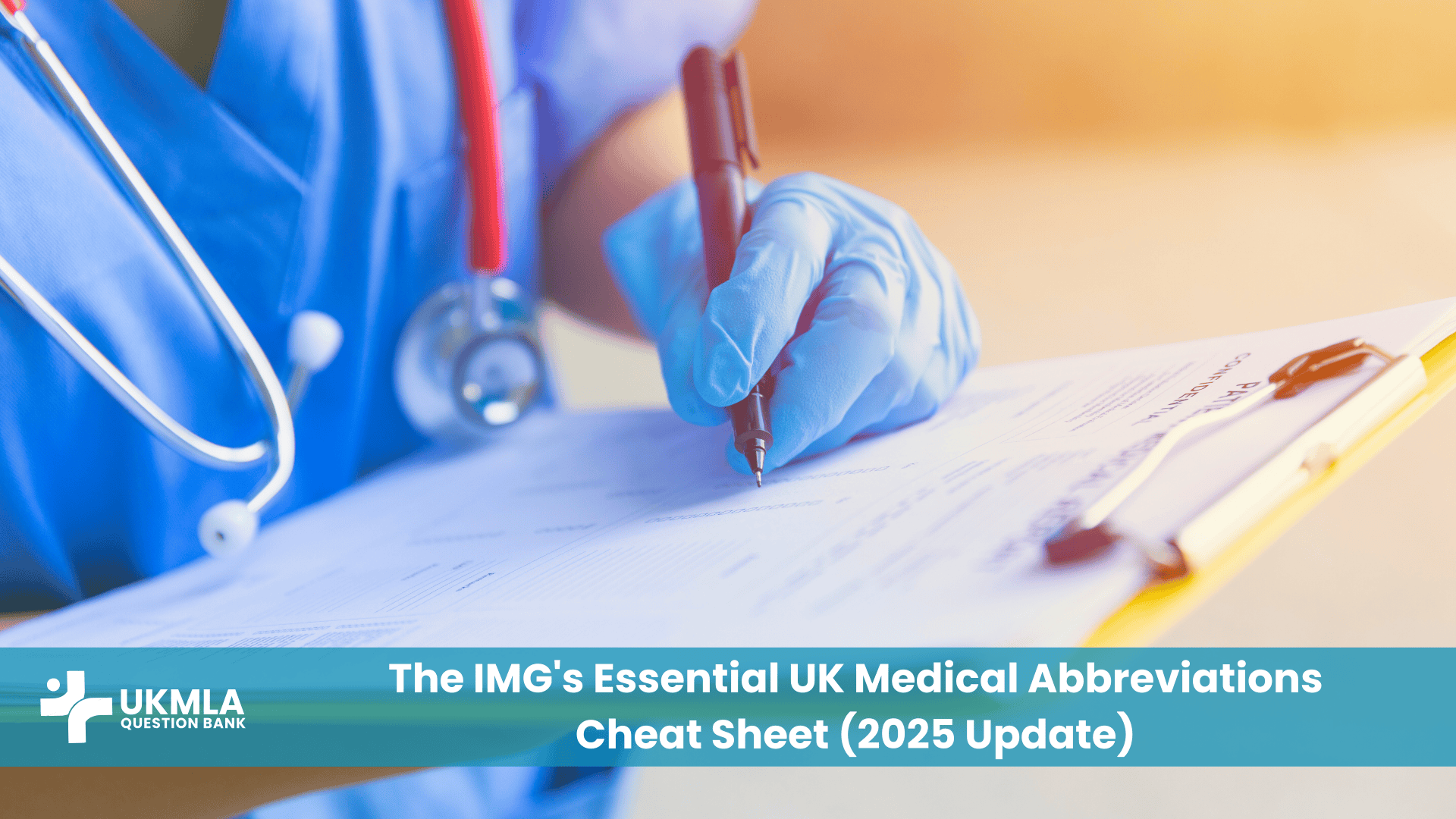Introduction
UK medical abbreviations for imgs represent a new dialect that must be learned quickly and accurately to thrive in the UK’s fast-paced clinical environment. For many International Medical Graduates, stepping onto an NHS ward for the first time can feel like an immersion into a world of acronyms and shorthand. From deciphering handwritten patient notes and interpreting lab requests to understanding handover sheets, fluency in this medical shorthand is not a luxury—it is an essential tool for effective communication and patient safety. This is a crucial part of the learning curve detailed in our broader UKMLA for IMGs: Step-by-Step Guide.
This guide is designed to be your definitive cheat sheet. We will demystify the most common abbreviations you’ll encounter in the UKMLA and your daily practice. We’ve categorized over 60 essential terms to help you build confidence, reduce clinical risk, and integrate smoothly into your new role within the NHS. Mastering this “language” is a fundamental step toward becoming a proficient and safe UK practitioner.
Table of Contents
ToggleA Guide to Common UK Medical Abbreviations for IMGs
Why Mastering Abbreviations is Crucial for the UKMLA & Beyond
A strong command of UK medical abbreviations is vital for two key reasons: exam success and safe clinical practice. In the UKMLA AKT, clinical vignettes are filled with this shorthand; misinterpreting a term like ‘SOB’ or ‘NBM’ can completely change the context of a question and lead to an incorrect answer. Understanding these terms is a core part of being able to effectively use GMC and UKMLA resources.
Beyond the exam, in the real-world setting of an NHS hospital, the stakes are even higher. Clear, unambiguous communication is the bedrock of patient safety. A simple misinterpretation can lead to significant medical errors. For IMGs, fluency in this local medical dialect also has a profound impact on professional confidence and integration. Being able to quickly understand notes and contribute effectively during ward rounds and handovers demonstrates competence and helps build trust with your new colleagues. It’s an unspoken part of fitting into the team and functioning as an efficient and reliable junior doctor. Authoritative bodies like the NICE (National Institute for Health and Care Excellence) Glossary exist to standardize terminology and ensure clarity across the health service.
The ‘Do Not Use’ List: Avoiding Common Pitfalls
Before diving into the common abbreviations, it’s critical to understand which ones to avoid. Patient safety organizations have identified several abbreviations that are frequently misinterpreted and have led to serious patient harm.
An NHS Patient Safety Alert highlights: “Ambiguous or unfamiliar abbreviations, acronyms, and symbols are a key source of error… Misinterpretation can have serious, sometimes fatal, consequences for the patient.”
Your guiding principle should always be clarity over speed. If there is any chance of ambiguity, write the term out in full. Below is a list of commonly cited dangerous abbreviations that you should avoid in your own writing.
Table 1: Commonly Discouraged or “Do Not Use” Abbreviations
| Do Not Use | Intended Meaning | Potential Misinterpretation | What to Write Instead |
| U | Units | Mistaken for a zero (0), four (4), or “cc”. | Write “units” in full. |
| IU | International Units | Mistaken for “IV” (intravenous) or the number 10. | Write “international units”. |
| Q.D. / Q.O.D. | Once daily / Every other day | The “O” can be mistaken for an “I”. | Write “daily” or “every other day”. |
| Trailing Zero (X.0 mg) | X mg | The decimal point can be missed, leading to a 10x overdose. | Write “X mg” (e.g., 5 mg). |
| Naked Decimal (.X mg) | 0.X mg | The decimal point can be missed, leading to an overdose. | Write “0.X mg” (e.g., 0.5 mg). |
| MS / MSO4 | Morphine Sulphate | Can be confused with Magnesium Sulphate (MgSO4). | Write “morphine sulphate”. |
How to Use This Guide
The following lists represent the most high-yield abbreviations you will encounter. They are grouped by clinical context to aid learning. While these are commonly used, you should always prioritize clarity and adhere to your local Trust’s policy on approved abbreviations. For more information on this, you can refer to resources on the NHS England Patient Safety website.
Common Abbreviations by Category
This section will provide a detailed list of common abbreviations you’ll encounter. Understanding these is the first step, but knowing how to apply them when interpreting clinical data for the UKMLA AKT and understanding UK Lab Values for the UKMLA is the crucial next step.
Investigations & Lab Results
This category is one of the first you’ll encounter. Abbreviations are used on blood forms, imaging requests, and in the electronic patient records where results are displayed. Being able to quickly decipher these is essential for preparing for ward rounds and making timely clinical decisions. It’s the language of diagnostics in the NHS.
Table 2: Investigations & Lab Results
| Abbreviation | Full Term | Context / Meaning |
| FBC | Full Blood Count | Standard blood test for red cells, white cells, and platelets. |
| U&Es | Urea and Electrolytes | Measures kidney function and electrolyte balance. |
| LFTs | Liver Function Tests | Measures markers of liver health and damage. |
| TFTs | Thyroid Function Tests | Measures thyroid hormone levels (e.g., TSH, T4). |
| CRP | C-Reactive Protein | A non-specific marker of inflammation. |
| ESR | Erythrocyte Sedimentation Rate | Another non-specific marker of inflammation. |
| ABG / VBG | Arterial / Venous Blood Gas | Measures blood oxygen, CO2, and acid-base balance. |
| CXR / AXR | Chest X-Ray / Abdominal X-Ray | Common imaging modalities. |
| CTPA | CT Pulmonary Angiogram | A CT scan specifically to look for a pulmonary embolism. |
| MRI | Magnetic Resonance Imaging | Advanced imaging using magnetic fields. |
| OGD | Oesophago-Gastro-Duodenoscopy | An endoscopic procedure to examine the upper GI tract. |
| INR | International Normalised Ratio | Measures blood clotting time, particularly for patients on warfarin. |
Prescribing & Medications
Precision is paramount in prescribing. These Latin-derived abbreviations have been used for centuries and still form the backbone of medication instructions on drug charts (or “kardexes”) and in electronic prescribing systems. Misinterpreting a frequency (e.g., TDS vs QDS) can lead to under-dosing or toxicity, making this a high-risk area for IMGs to master.
Table 3: Prescribing & Medications
| Abbreviation | Full Term | Context / Meaning |
| OD | omne in die (once a day) | To be taken once every 24 hours. |
| BD / BID | bis in die (twice a day) | To be taken twice every 24 hours (e.g., 8 am and 8 pm). |
| TDS / TID | ter die sumendus (three times a day) | To be taken three times every 24 hours (e.g., 8 am, 2 pm, 10 pm). |
| QDS / QID | quater die sumendus (four times a day) | To be taken four times every 24 hours. |
| PRN | pro re nata (as needed) | To be taken when required (e.g., for pain). |
| STAT | statim (immediately) | To be given immediately. |
| PO | per os (by mouth) | To be taken orally. |
| IV / IM / SC | Intravenous / Intramuscular / Subcutaneous | Routes of injection. |
| NBM | Nil By Mouth | Patient should not eat or drink. |
| NG / PEG | Nasogastric / Percutaneous Endoscopic Gastrostomy | Types of feeding tubes. |
Clinical Notes & Handovers
The structure of medical note-keeping and handover in the UK is steeped in abbreviation. This shorthand allows for the rapid documentation and communication of complex patient information. Understanding these terms is essential for reading historical patient records, writing your own clear and concise notes, and participating in safety-critical processes like the morning handover meeting.
Table 4: Clinical Notes & Handovers
| Abbreviation | Full Term | Context / Meaning |
| c/o | Complaining of | The patient’s presenting symptom (e.g., “c/o chest pain”). |
| o/e | On Examination | Findings from the physical examination. |
| h/o | History of | Past events (e.g., “h/o similar episodes”). |
| PMH / DH / SH | Past Medical / Drug / Social History | Standard components of a patient history. |
| HPC | History of Presenting Complaint | The detailed story of the patient’s main symptom. |
| SOB | Shortness of Breath | A common presenting symptom. |
| NAD | No Abnormality Detected | Often used when examination findings are normal. |
| TCI | To Come In | Patient is scheduled for admission. |
| NFA | No Further Action | No further treatment or investigation is planned at this time. |
| DNACPR | Do Not Attempt Cardiopulmonary Resuscitation | An official order regarding end-of-life care. |
| EOLC | End of Life Care | The care plan for a terminally ill patient. |
| TTO / TTA | To Take Out / To Take Away | Discharge medications for the patient to take home. |
| ADL | Activities of Daily Living | Refers to a patient’s functional independence. |
Common Conditions & Departments
This final category covers the acronyms used in everyday conversation on the wards. Doctors will refer to patients by their diagnosis (e.g., “the patient with ACS in bed 5”) or mention referrals to other departments (e.g., “we need a T&O review”). Knowing these is key to understanding the daily flow of hospital life and inter-specialty communication.
Table 5: Common Conditions & Departments
| Abbreviation | Full Term | Context / Meaning |
| MI / ACS | Myocardial Infarction / Acute Coronary Syndrome | Heart attack / related cardiac emergencies. |
| CVA | Cerebrovascular Accident | A stroke. |
| PE / DVT | Pulmonary Embolism / Deep Vein Thrombosis | Blood clots in the lungs / legs. |
| COPD | Chronic Obstructive Pulmonary Disease | A common respiratory condition. |
| AKI / CKD | Acute Kidney Injury / Chronic Kidney Disease | Types of kidney dysfunction. |
| T1DM / T2DM | Type 1 / Type 2 Diabetes Mellitus | Common endocrine disorders. |
| AF | Atrial Fibrillation | A common type of irregular heartbeat. |
| UTI | Urinary Tract Infection | A common infection. |
| A&E | Accident & Emergency | The emergency department of a hospital. |
| GP | General Practitioner | A primary care doctor. |
| ICU / ITU | Intensive Care Unit / Intensive Therapy Unit | Where the most critically ill patients are cared for. |
| T&O | Trauma & Orthopaedics | The surgical specialty dealing with bones and joints. |
Tips for Learning and Remembering Abbreviations
Create Flashcards: Using an app like Anki or Quizlet allows for spaced repetition, which is a highly effective learning technique. You can create decks for each category and test yourself during your commute or downtime.
Context is Key: Don’t just memorize the list in isolation. Actively look for these abbreviations when you are working through question banks or reading UK-based clinical guidelines. Seeing a term used in a full clinical scenario makes it far more memorable.
Ask When Unsure: This is the most important tip. Never guess the meaning of an abbreviation if there is even a sliver of doubt. It is always safer and more professional to ask a senior colleague for clarification. This shows you are safety-conscious, not incompetent.
Keep a Notebook: Carry a small pocket notebook or use a notes app on your phone. When you encounter a new abbreviation, jot it down and look it up later. This active learning process helps cement the knowledge.
Frequently Asked Questions (FAQ) about UK Medical Abbreviations
Functionally, they mean the same thing: the patient’s discharge medications. TTO (To Take Out) is a more traditional term, while TTA (To Take Away) is also widely used. The exact term may vary by hospital, but the meaning is understood to be the same.
Yes, absolutely. The NHS and patient safety bodies strongly discourage any abbreviation that could be ambiguous. The most critical ones to avoid are ‘U’ for units (write ‘units’), ‘IU’ for international units, and trailing zeros on dosages (write ‘5 mg’, not ‘5.0 mg’). Always prioritize clarity to prevent medication errors.
No, there is not a single, comprehensive national list that all hospitals must use. While the majority of terms in this guide are universally understood, individual NHS Trusts often have their own local policies, including lists of approved and discouraged abbreviations. Always familiarize yourself with local hospital policy when you start a new job.
This is a significant potential source of error. The meaning is almost always determined by the clinical context. For example, ‘RA’ could mean Rheumatoid Arthritis in a rheumatology clinic, or Room Air on a blood gas result. The surrounding clinical information is essential for correct interpretation.
The UKMLA uses standard, widely accepted UK medical abbreviations. You will be expected to know common terms like those in this guide. You will not be tested on obscure, ambiguous, or purely local hospital shorthand.
When speaking to a patient (or a simulated patient) in the CPSA, you should never use medical abbreviations or jargon. Communication must always be in clear, simple language that a layperson can understand. You may, however, see abbreviations in the written instructions for the station.
They refer to the same place: the Intensive Care Unit or Intensive Therapy Unit. The term used often varies by hospital, but both are understood to mean the department where the most critically ill patients are managed.
This is a historical convention from Latin, which was the traditional language of medicine and prescriptions. While still extremely common, there is a gradual movement in modern medicine towards writing instructions out in full to improve clarity and reduce the risk of error.
DNACPR (Do Not Attempt Cardiopulmonary Resuscitation) is the officially recognized and legally robust term in the UK. You may still see the older, less precise term DNAR (Do Not Attempt Resuscitation) in older notes, but DNACPR is the correct term to use in your own documentation and discussions.
Immersion is the most effective method. Regularly use UK-based question banks like UKMLAQuestionBank.com, read UK clinical guidelines from NICE, and if possible, spend time in a UK clinical setting (such as a clinical attachment). Active engagement with the language is far more effective than passive memorization.
Conclusion
Learning UK medical abbreviations is like learning a new, essential dialect. It is a fundamental skill that bridges the gap between theoretical knowledge and effective, safe clinical practice in the NHS. While the sheer number of acronyms can seem daunting at first, focusing on the high-yield terms in this guide will rapidly build your confidence and competence.
Think of this list not as a task to be memorized, but as a key to unlock clearer communication. It allows you to understand your colleagues, contribute effectively to patient care, and navigate your new clinical environment with ease. By mastering this medical shorthand, you are taking a crucial step in your successful transition to becoming a trusted and proficient doctor in the UK medical system.




